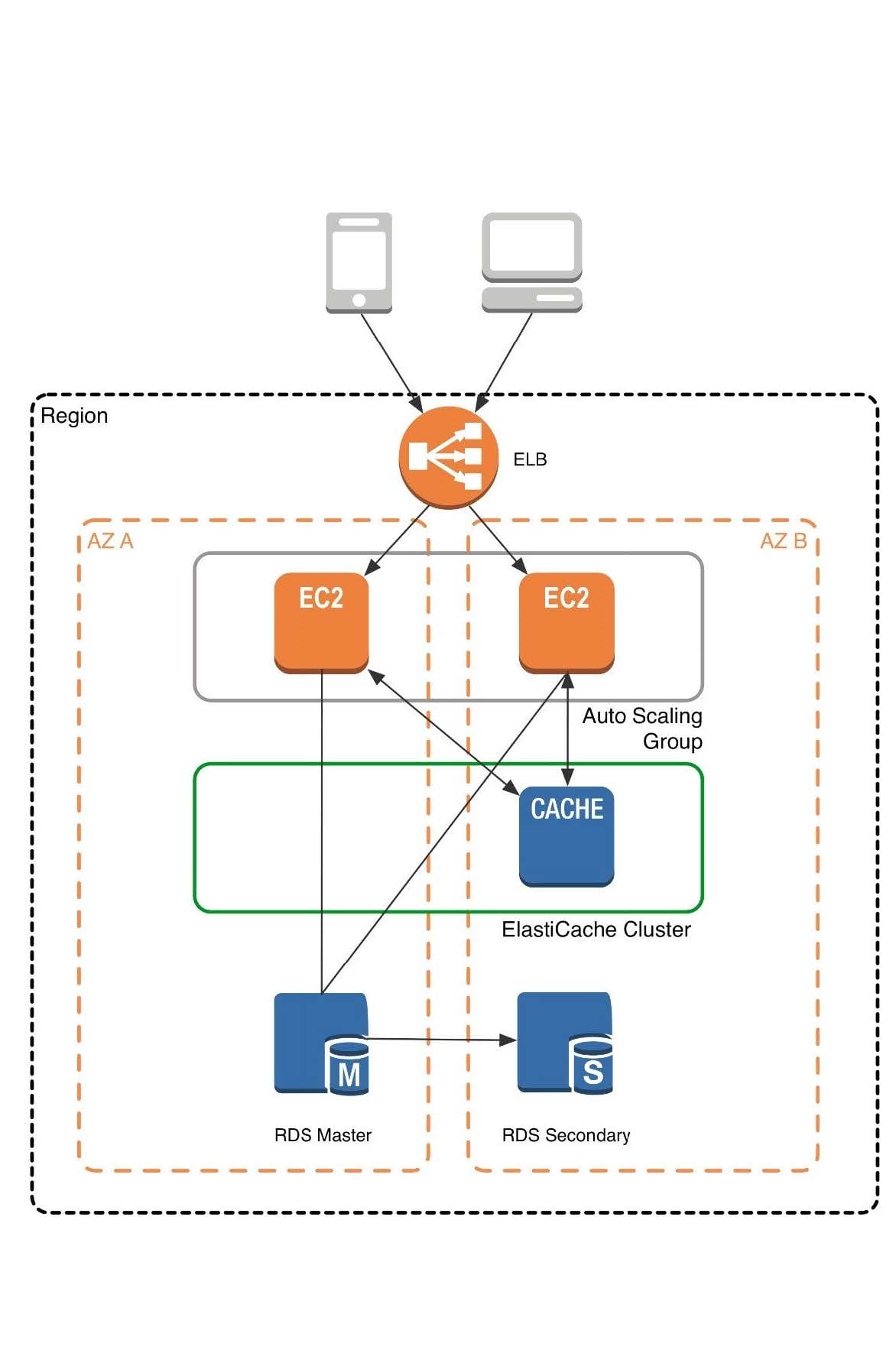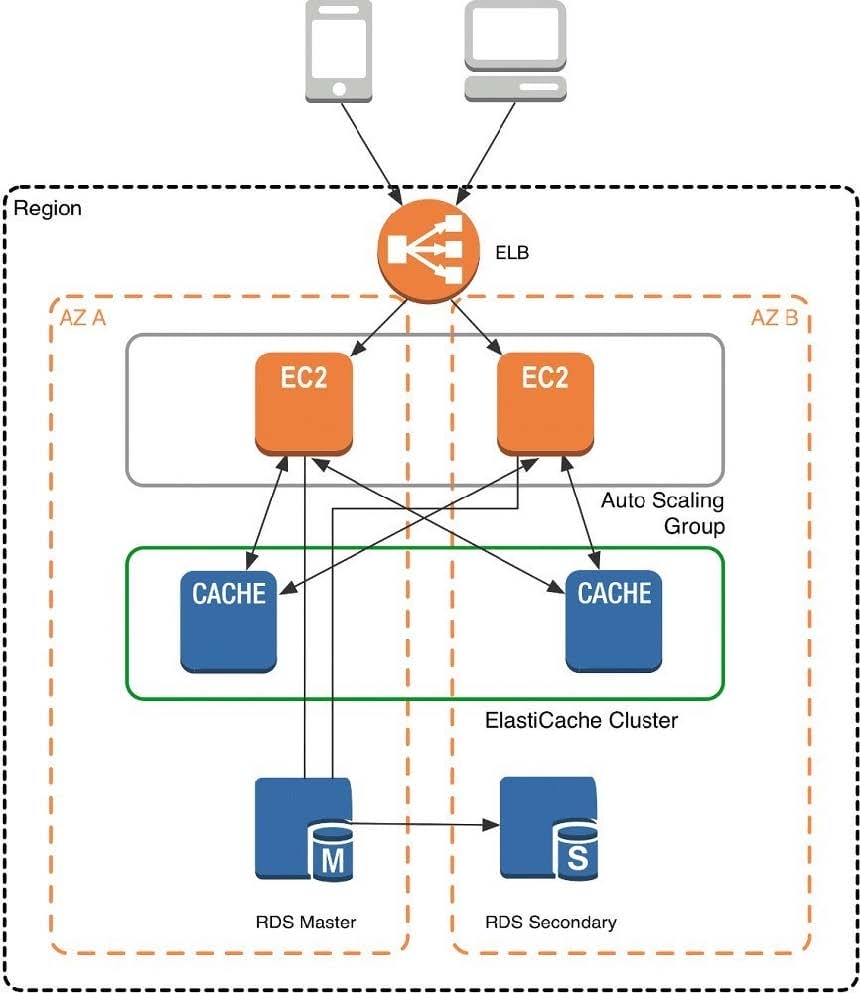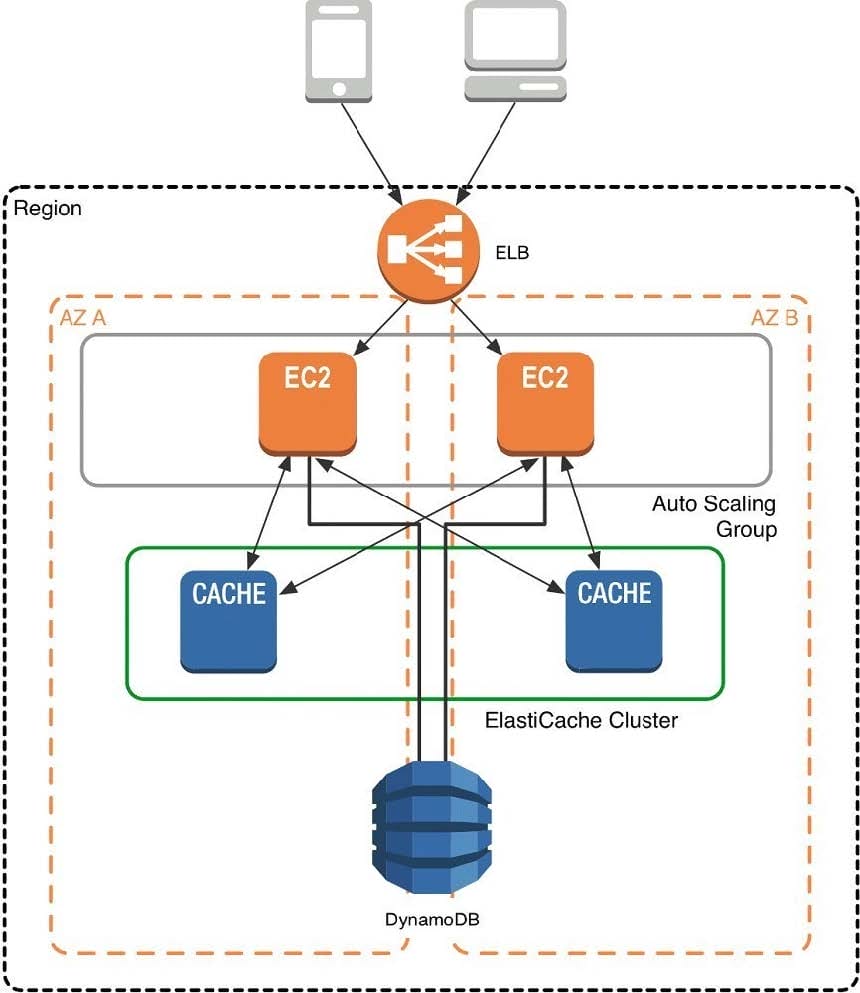Exam Details
Exam Code
:SAP-C01Exam Name
:AWS Certified Solutions Architect - Professional (SAP-C01)Certification
:Amazon CertificationsVendor
:AmazonTotal Questions
:973 Q&AsLast Updated
:Jul 09, 2023
Amazon Amazon Certifications SAP-C01 Questions & Answers
-
Question 961:
Your application is using an ELB in front of an Auto Scaling group of web/application servers deployed across two AZs and a Multi-AZ RDS Instance for data persistence. The database CPU is often above 80% usage and 90% of I/O operations on the database are reads. To improve performance you recently added a single-node Memcached ElastiCache Cluster to cache frequent DB query results. In the next weeks the overall workload is expected to grow by 30%.
Do you need to change anything in the architecture to maintain the high availability or the application with the anticipated additional load? Why?
A. Yes, you should deploy two Memcached ElastiCache Clusters in different AZs because the RDS instance will not be able to handle the load if the cache node fails.
B. No, if the cache node fails you can always get the same data from the DB without having any availability impact.
C. No, if the cache node fails the automated ElastiCache node recovery feature will prevent any availability impact.
D. Yes, you should deploy the Memcached ElastiCache Cluster with two nodes in the same AZ as the RDS DB master instance to handle the load if one cache node fails.
-
Question 962:
You are implementing AWS Direct Connect. You intend to use AWS public service end points such as Amazon S3, across the AWS Direct Connect link. You want other Internet traffic to use your existing link to an Internet Service Provider.
What is the correct way to configure AWS Direct connect for access to services such as Amazon S3?
A. Configure a public Interface on your AWS Direct Connect link. Configure a static route via your AWS Direct Connect link that points to Amazon S3 Advertise a default route to AWS using BGP.
B. Create a private interface on your AWS Direct Connect link. Configure a static route via your AWS Direct connect link that points to Amazon S3 Configure specific routes to your network in your VPC.
C. Create a public interface on your AWS Direct Connect link. Redistribute BGP routes into your existing routing infrastructure; advertise specific routes for your network to AWS.
D. Create a private interface on your AWS Direct connect link. Redistribute BGP routes into your existing routing infrastructure and advertise a default route to AWS.
-
Question 963:
Your team has a tomcat-based Java application you need to deploy into development, test and production environments. After some research, you opt to use Elastic Beanstalk due to its tight integration with your developer tools and RDS due to its ease of management. Your QA team lead points out that you need to roll a sanitized set of production data into your environment on a nightly basis. Similarly, other software teams in your org want access to that same restored data via their EC2 instances in your VPC.
The optimal setup for persistence and security that meets the above requirements would be the following.
A. Create your RDS instance as part of your Elastic Beanstalk definition and alter its security group to allow access to it from hosts in your application subnets.
B. Create your RDS instance separately and add its IP address to your application's DB connection strings in your code Alter its security group to allow access to it from hosts within your VPC's IP address block.
C. Create your RDS instance separately and pass its DNS name to your app's DB connection string as an environment variable. Create a security group for client machines and add it as a valid source for DB traffic to the security group of the RDS instance itself.
D. Create your RDS instance separately and pass its DNS name to your's DB connection string as an environment variable Alter its security group to allow access to It from hosts in your application subnets.
-
Question 964:
Your company has an on-premises multi-tier PHP web application, which recently experienced downtime due to a large burst in web traffic due to a company announcement Over the coming days, you are expecting similar announcements to drive similar unpredictable bursts, and are looking to find ways to quickly improve your infrastructures ability to handle unexpected increases in traffic. The application currently consists of 2 tiers a web tier which consists of a load balancer and several Linux Apache web servers as well as a database tier which hosts a Linux server hosting a MySQL database.
Which scenario below will provide full site functionality, while helping to improve the ability of your application in the short timeframe required?
A. Failover environment: Create an S3 bucket and configure it for website hosting. Migrate your DNS to Route53 using zone file import, and leverage Route53 DNS failover to failover to the S3 hosted website.
B. Hybrid environment: Create an AMI, which can be used to launch web servers in EC2. Create an Auto Scaling group, which uses the AMI to scale the web tier based on incoming traffic. Leverage Elastic Load Balancing to balance traffic between on-premises web servers and those hosted in AWS.
C. Offload traffic from on-premises environment: Setup a CIoudFront distribution, and configure CloudFront to cache objects from a custom origin. Choose to customize your object cache behavior, and select a TTL that objects should exist in cache.
D. Migrate to AWS: Use VM Import/Export to quickly convert an on-premises web server to an AMI. Create an Auto Scaling group, which uses the imported AMI to scale the web tier based on incoming traffic. Create an RDS read replica and setup replication between the RDS instance and on-premises MySQL server to migrate the database.
-
Question 965:
You are designing Internet connectivity for your VPC. The Web servers must be available on the Internet. The application must have a highly available architecture.
Which alternatives should you consider? (Choose two.)
A. Configure a NAT instance in your VPC. Create a default route via the NAT instance and associate it with all subnets. Configure a DNS A record that points to the NAT instance public IP address.
B. Configure a CloudFront distribution and configure the origin to point to the private IP addresses of your Web servers. Configure a Route53 CNAME record to your CloudFront distribution.
C. Place all your web servers behind ELB. Configure a Route53 CNMIE to point to the ELB DNS name.
D. Assign EIPs to all web servers. Configure a Route53 record set with all EIPs, with health checks and DNS failover.
E. Configure ELB with an EIP. Place all your Web servers behind ELB. Configure a Route53 A record that points to the EIP.
-
Question 966:
Your firm has uploaded a large amount of aerial image data to S3. In the past, in your on-premises environment, you used a dedicated group of servers to oaten process this data and used Rabbit MQ - An open source messaging system to get job information to the servers. Once processed the data would go to tape and be shipped offsite. Your manager told you to stay with the current design, and leverage AWS archival storage and messaging services to minimize cost.
Which is correct?
A. Use SQS for passing job messages use Cloud Watch alarms to terminate EC2 worker instances when they become idle. Once data is processed, change the storage class of the S3 objects to Reduced Redundancy Storage.
B. Setup Auto-Scaled workers triggered by queue depth that use spot instances to process messages in SOS Once data is processed, change the storage class of the S3 objects to Reduced Redundancy Storage.
C. Setup Auto-Scaled workers triggered by queue depth that use spot instances to process messages in SQS Once data is processed, change the storage class of the S3 objects to Glacier.
D. Use SNS to pass job messages use Cloud Watch alarms to terminate spot worker instances when they become idle. Once data is processed, change the storage class of the S3 object to Glacier.
-
Question 967:
You've been hired to enhance the overall security posture for a very large e-commerce site. They have a well architected multi-tier application running in a VPC that uses ELBs in front of both the web and the app tier with static assets served directly from S3. They are using a combination of RDS and DynamoDB for their dynamic data and then archiving nightly into S3 for further processing with EMR. They are concerned because they found questionable log entries and suspect someone is attempting to gain unauthorized access.
Which approach provides a cost effective scalable mitigation to this kind of attack?
A. Recommend that they lease space at a DirectConnect partner location and establish a 1G DirectConnect connection to their VPC they would then establish Internet connectivity into their space, filter the traffic in hardware Web Application Firewall (WAF). And then pass the traffic through the DirectConnect connection into their application running in their VPC.
B. Add previously identified hostile source IPs as an explicit INBOUND DENY NACL to the web tier subnet.
C. Add a WAF tier by creating a new ELB and an AutoScaling group of EC2 Instances running a host-based WAF. They would redirect Route 53 to resolve to the new WAF tier ELB. The WAF tier would their pass the traffic to the current web tier The web tier Security Groups would be updated to only allow traffic from the WAF tier Security Group
D. Remove all but TLS 1.2 from the web tier ELB and enable Advanced Protocol Filtering. This will enable the ELB itself to perform WAF functionality.
-
Question 968:
Your company is in the process of developing a next generation pet collar that collects biometric information to assist families with promoting healthy lifestyles for their pets. Each collar will push 30kb of biometric data in JSON format every 2 seconds to a collection platform that will process and analyze the data providing health trending information back to the pet owners and veterinarians via a web portal. Management has tasked you to architect the collection platform ensuring the following requirements are met.
1.
Provide the ability for real-time analytics of the inbound biometric data
2.
Ensure processing of the biometric data is highly durable. Elastic and parallel
3.
The results of the analytic processing should be persisted for data mining
Which architecture outlined below win meet the initial requirements for the collection platform?
A. Utilize S3 to collect the inbound sensor data analyze the data from S3 with a daily scheduled Data Pipeline and save the results to a Redshift Cluster.
B. Utilize Amazon Kinesis to collect the inbound sensor data, analyze the data with Kinesis clients and save the results to a Redshift cluster using EMR.
C. Utilize SQS to collect the inbound sensor data analyze the data from SQS with Amazon Kinesis and save the results to a Microsoft SQL Server RDS instance.
D. Utilize EMR to collect the inbound sensor data, analyze the data from EUR with Amazon Kinesis and save me results to DynamoDB.
-
Question 969:
A company is storing data on Amazon Simple Storage Service (S3). The company's security policy mandates that data is encrypted at rest.
Which of the following methods can achieve this? (Choose three.)
A. Use Amazon S3 server-side encryption with AWS Key Management Service managed keys.
B. Use Amazon S3 server-side encryption with customer-provided keys.
C. Use Amazon S3 server-side encryption with EC2 key pair.
D. Use Amazon S3 bucket policies to restrict access to the data at rest.
E. Encrypt the data on the client-side before ingesting to Amazon S3 using their own master key.
F. Use SSL to encrypt the data while in transit to Amazon S3.
-
Question 970:
A web company is looking to implement an intrusion detection and prevention system into their deployed VPC. This platform should have the ability to scale to thousands of instances running inside of the VPC.
How should they architect their solution to achieve these goals?
A. Configure an instance with monitoring software and the elastic network interface (ENI) set to promiscuous mode packet sniffing to see an traffic across the VPC.
B. Create a second VPC and route all traffic from the primary application VPC through the second VPC where the scalable virtualized IDS/IPS platform resides.
C. Configure servers running in the VPC using the host-based 'route' commands to send all traffic through the platform to a scalable virtualized IDS/IPS.
D. Configure each host with an agent that collects all network traffic and sends that traffic to the IDS/IPS platform for inspection.
Related Exams:
AIF-C01
Amazon AWS Certified AI Practitioner (AIF-C01)ANS-C00
AWS Certified Advanced Networking - Specialty (ANS-C00)ANS-C01
AWS Certified Advanced Networking - Specialty (ANS-C01)AXS-C01
AWS Certified Alexa Skill Builder - Specialty (AXS-C01)BDS-C00
AWS Certified Big Data - Speciality (BDS-C00)CLF-C02
AWS Certified Cloud Practitioner (CLF-C02)DAS-C01
AWS Certified Data Analytics - Specialty (DAS-C01)DATA-ENGINEER-ASSOCIATE
AWS Certified Data Engineer - Associate (DEA-C01)DBS-C01
AWS Certified Database - Specialty (DBS-C01)DOP-C02
AWS Certified DevOps Engineer - Professional (DOP-C02)
Tips on How to Prepare for the Exams
Nowadays, the certification exams become more and more important and required by more and more enterprises when applying for a job. But how to prepare for the exam effectively? How to prepare for the exam in a short time with less efforts? How to get a ideal result and how to find the most reliable resources? Here on Vcedump.com, you will find all the answers. Vcedump.com provide not only Amazon exam questions, answers and explanations but also complete assistance on your exam preparation and certification application. If you are confused on your SAP-C01 exam preparations and Amazon certification application, do not hesitate to visit our Vcedump.com to find your solutions here.


